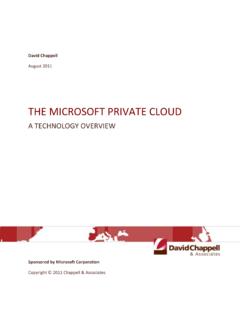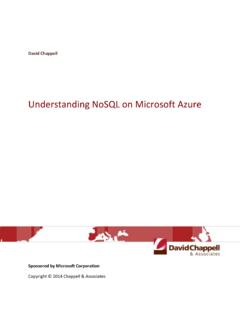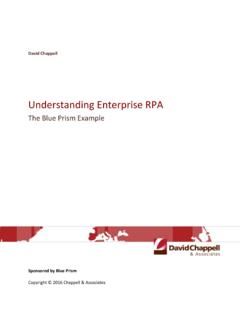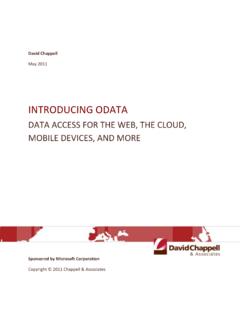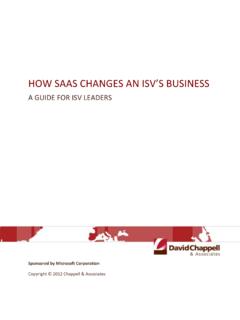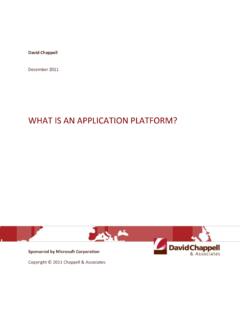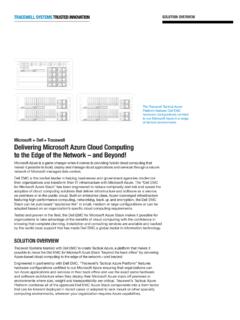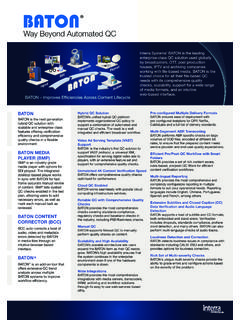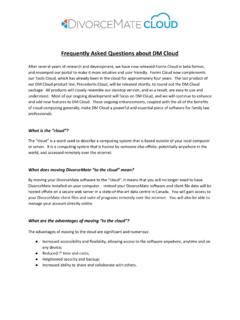Transcription of Introducing the Windows Azure Platform
1 Introducing THE Windows Azure Platform DAVID CHAPPELL OCTOBER 2010 SPONSORED BY microsoft CORPORATION 2 CONTENTS An Overview of the Windows Azure Platform .. 3 Windows Azure .. 4 SQL Azure .. 6 Windows Azure 8 Windows Azure MarketPlace .. 9 A Closer Look at the Technologies .. 10 Windows Azure .. 10 Compute .. 11 Storage .. 12 Fabric Controller .. 14 Content Delivery Network .. 14 Connect .. 15 SQL Azure .. 15 Database .. 15 Reporting .. 17 Data Sync .. 17 Windows Azure 19 Service Bus .. 19 Access Control .. 21 Caching .. 23 Windows Azure Marketplace .. 24 Looking Ahead .. 26 Conclusions .. 26 About the Author .. 27 3 AN OVERVI EW OF T HE WI N DOWS Azure PLAT FORM Using computers in the cloud can make lots of sense. Rather than buying and maintaining your own machines, why not exploit the acres of Internet-accessible servers on offer today?
2 For some applications, both code and data might live in the cloud , where somebody else manages and maintains the systems they use. Alternatively, applications that run inside an organization on-premises applications might store data in the cloud or rely on other cloud infrastructure services. However it s done, exploiting the cloud s capabilities can improve our world. But whether an application runs in the cloud , uses services provided by the cloud , or both, some kind of application Platform is required. Viewed broadly, an application Platform can be thought of as anything that provides developer-accessible services for creating applications or storing data. In the on-premises Windows world, this includes technologies such as Windows Server and SQL Server. To let applications exploit the cloud , a cloud application Platform must also exist.
3 This is exactly what the microsoft Windows Azure Platform provides. It s a group of cloud technologies, each providing a specific set of services to application developers. Figure 1 shows its components. Figure 1: The Windows Azure Platform supports applications, data, and infrastructure in the cloud , together with a cloud marketplace. The Windows Azure Platform today has four parts: Windows Azure : A Windows environment for running applications and storing data on computers in microsoft data centers. SQL Azure : Relational data services in the cloud based on SQL Server. Windows Azure AppFabric: cloud -based infrastructure services for applications running in the cloud or on premises. 4 Windows Azure Marketplace: An online service for purchasing cloud -based data and applications.
4 All four of these components run in microsoft data centers located around the world: two in North America, two in Europe, and two in Asia. Developers using the Platform can control which data center runs their applications and stores their data, giving them the ability to place both closer to their users. Each part of the Windows Azure Platform has its own role to play. This overview describes all four, first at a high level, then in a bit more detail. The goal is to provide a big-picture introduction to this cloud Platform . WIND OWS Azure At a high level, Windows Azure is simple to understand: It runs Windows applications and stores data in the cloud . Figure 2 shows its components. Figure 2: Windows Azure provides compute and storage services in the cloud . The five parts of Windows Azure today are the following: Compute: The Windows Azure compute service runs applications on a Windows Server foundation.
5 These applications can be created using the .NET Framework in languages such as C# and Visual Basic, or they can be built without .NET in C++, Java, and other languages. Developers can use Visual Studio or other development tools, and they re free to use technologies such as , Windows Communication Foundation (WCF), and PHP. Storage: This service allows storing binary large objects (blobs), provides queues for communication between components of Windows Azure applications, and even offers a form of tables with a simple query language. ( Windows Azure applications that need traditional relational storage can also use 5 SQL Azure .) Both Windows Azure applications and on-premises applications can access the Windows Azure storage service, and both do it in the same way: using a RESTful approach.
6 Fabric controller: As the figure suggests, Windows Azure runs on a large number of machines. The fabric controller s job is to knit the machines in a single Windows Azure data center into a cohesive whole. The Windows Azure compute and storage services are then built on top of this pool of processing power. Content delivery network (CDN): Caching frequently accessed data closer to its users speeds up access to that data. The Windows Azure CDN can do this for blobs, maintaining cached copies at sites around the world. Connect: It s often useful for organizations to interact with cloud applications as if they were inside the organization s own firewall. Windows Azure Connect allows this, making it easier for, say, a Windows Azure application to access an on-premises database.
7 Running applications and storing data in the cloud can have clear benefits. Rather than buying, installing, and operating its own systems, for example, an organization can rely on a cloud provider to do this for them. Also, customers pay just for the computing and storage they use, rather than maintaining a large set of servers only for peak loads. And applications written for Windows Azure can scale better, be more reliable, and require less administration than those written using the traditional Windows Server programming model. To create, configure, and monitor applications, Windows Azure customers can use a browser-accessible portal. A customer logs in with a Windows Live ID, then chooses whether to create a hosting account for running applications, a storage account for storing data, or both.
8 microsoft then charges each customer based on how much compute time, storage, and bandwidth that customer uses. How an application charges its own customers if it charges them at all is entirely up to the people who create that application. Windows Azure is a general Platform that can be used in a broad set of scenarios. Here are a few examples: An independent software vendor (ISV) creating a software-as-a-service (SaaS) version of an existing on-premises Windows application might choose to build it on Windows Azure . Because Windows Azure mostly provides a standard Windows environment, moving the application s business logic to this cloud Platform won t typically pose many problems. And once again, building on an existing Platform lets the ISV focus on business logic the thing that makes them money rather than spending time on infrastructure.
9 An enterprise creating an application for its customers or employees might choose to build it on Windows Azure . Because Windows Azure supports .NET, developers with the right skills aren t difficult to find, nor are they prohibitively expensive. Running the application in microsoft data centers frees the enterprise from the responsibility and expense of managing its own servers, turning capital expenses into operating expenses. And especially if the application has spikes in usage maybe it s an on-line flower store that must handle the Mother s Day rush letting microsoft maintain the large server base required for this can make economic sense. 6 A start-up creating a new Web site the next Facebook, say could build its application on Windows Azure .
10 Because this Platform supports both Web-facing services and background processes, the application can provide an interactive user interface as well as executing work for users asynchronously. Rather than spending time and money worrying about infrastructure, the start-up can instead focus solely on creating code that provides value to its customers and investors. The company can also start small, incurring low costs while its application has only a few users. If the application catches on and usage increases, Windows Azure can scale the application as needed. These three examples illustrate the kinds of things organizations might do with Windows Azure , but they re not an exhaustive list. As interest in cloud computing continues to grow, expect to see a variety of applications created for this cloud Platform .
